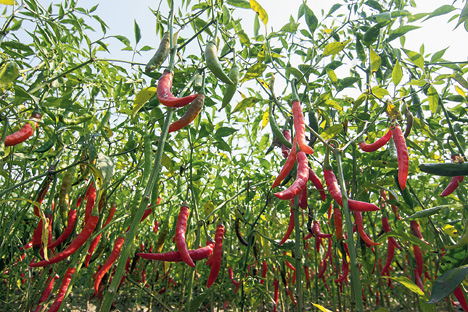

S.K. Maiti, patron of Bidhannagar Horticultural Society and a civil engineer residing in FC Block, offers guidance on choosing herbs to suit Salt Lake’s soil and climate
Too much of it would leave you in tears, red-faced and sweating but its absence would make your favourite dishes taste bland. The hot herb chilli is indispensable in Indian cooking and luckily, it grows fairly well in Salt Lake soil.
Also called Red Pepper, the pungent fruits of the Chilli is grown for its green, ripe and sometime also its dried forms. There is a controversy, however, regarding the origin of this condiment crop. Some experts are in the opinion that it is indigenous to Mexico, Central America, the West Indies and much of South Africa but others believe that it is indigenous to the Andaman islands.
In India Chilli is grown in almost all states and India is a major exporter of the crop. Andhra Pradesh is the largest Chilli-growing state followed by Karnataka and Maharashtra.
It is generally recognised that there are five cultivated varieties chillies — C. annuum, C.frutescens, C. chinense, C.pendulam and C.pubescens. Among these C.annuum is very popular and cultivated throughout India.
Many important cultivars have been recommended by Indian Agricultural Research Institute, New Delhi for cultivation in India. Some of them are Arka Lohit, Jawahar 218, Pusa Sadabahar, NP-46A etc. The Hybrids Agni and Arch 228 are high-yielding.

Cultivation
The Chilli is a perennial herb that grows to a height of about a metre, has a woody stem and white flowers with a greenish tinge.
Climate and Soil:- The plant belongs to tropical and sub-tropical regions requiring a warm humid climate. It is grown from sea level up to an altitude of 2,000m above Mean Sea Level. As a rain-fed crop, it is grown in areas that receive an annual rainfall of 75-100cm.
Very heavy rainfall during crop growth is harmful as it causes defoliation and rotting of the plant.
Chilli is better grown in a well-drained and fairly light fertile loam with a fair moisture-holding capacity. Chilli crops prefer soil reaction ranging from pH 6-7.
Preparation of bed:- The bed should be prepared by repeated harrowing until a fine tilth is obtained. Farm Yard Manure (FYM) of 2.5 to 3kg per sq metre should be added to the soil at the time of bed preparation.
Planting:- The winter crop is planted between July and September and the hot weather crop between February and March. The seed is first sown in the nursery bed and seedlings are transplanted when five to six weeks old.
The nursery bed should be prepared near partially shaded areas. Seeds are sown thinly in lines spaced 5cm apart. Sand and well-decomposed compost are sprinkled over the seeds.
Mulching with paddy straw should be done soon after sowing. Seeds would germinate in six to 10 days and the mulch should be removed as soon as the seeds start germinating. Seedlings become ready for transplanting 35 to 45 days after sowing.

For planting, 1m wide beds should be prepared and seedlings should be planted in 45 - 60cm intervals in straight rows.
Fertilising:- Sufficient quantity of FYM should be added to the soil at the time of bed preparation. A top dressing of 100g of ammonium sulphate, 50g of single super phosphate and 30g of potassium sulphate per square meter is recommended.
A full dose of phosphate and potash and half dose of ammonium sulphate is to be applied at the time of transplantation and the remaining ammonium sulphate should be as added as top dressing during earthing. This should be done 30 days after transplanting. Mulching prevents weed growth.
Irrigation and inter-culture: In West Bengal major areas under Chilli cultivation are rain-fed. When there is insufficient rainfall the crop should be irrigated frequently.

Harvesting: The first round of picking should be done when the fruits are green. This stimulates further flush of flowers and fruits. Chillis for vegetable purposes, is generally harvested at the full-grown stage, whereas for dried chilli, the ripe red stage is ideal. Since dried Chillis are an export-earning commodity, its timely harvesting, curing and grading are crucial.
Nutrition: Chillies are rich in vitamins, especially vitamins A and C and it also contains carbohydrates, protein and various minerals. It is generally used in pickles and chutnies. The pungency in Chillies is due to an alkaloid called capsaicin that is contained in the skin and sepal.
In the July - August season, Ningxiang in China hosts a Chilli-eating competition and he who eats the most Chillies in one minute, wins.
• Concluded










